|
|
|
Sort Order |
|
|
|
Items / Page
|
|
|
|
|
|
|
| Srl | Item |
| 1 |
ID:
118871
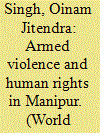

|
|
|
| 2 |
ID:
183923
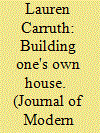

|
|
|
|
|
| Summary/Abstract |
This study uses ethnography along Ethiopian women's irregular migration routes through Djibouti to analyse the complex reasons women leave home to seek labour opportunities in the Gulf States. Theories and policies that either narrowly depict women's motivations as economic in nature or focus only on women's needs for security and protection, fail to account both for the politics of seeking employment abroad, and the ways migration provides women a potential refuge from various forms of violence at home. Using a feminist analysis, we argue that women do not migrate only for financial opportunities, but also to escape combinations of domestic, political and structural violence. As such, irregular migration both evinces a failure of asylum systems and humanitarian organisations to protect Ethiopians, and a failure of the state to provide Ethiopian women meaningful citizenship. Lacking both protection and meaningful citizenship, international migration represents women's journeys for opportunity and emancipation.
|
|
|
|
|
|
|
|
|
|
|
|
|
|
|
|
| 3 |
ID:
107666
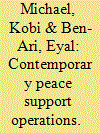

|
|
|
|
|
| Publication |
2011.
|
| Summary/Abstract |
In this article the authors examine two set of issues that constrain contemporary peace support operations (PSOs): one centered on the kinds of knowledge prevalent in PSOs and the second involving the organizational structures that characterize them. The authors' aim is to show the deep discursive and structural limitations and contradictions that continue to characterize the actions of armed forces and the dominance of militaristic thinking within PSOs. This article centers on multidimensional peacekeeping marked by emphasizing two main points in regard to the complex nature of such peacekeeping. First, Western military thinking is still dominant in the professional discourse of peacekeeping despite the fact that in many cases it is less relevant to the arenas where it is applied (in weakened or failed states). Second, forces in second-generation peacekeeping missions are by definition a form of hybrid organizations, and therefore conceptual changes in regard to PSOs not only involve the realm of knowledge but also entail practical consequences for the very organizational means used to achieve their aims. The authors' analysis demonstrates the blending, hybridization, and linkages that are an essential part of PSOs as processes that carry both advantages and disadvantages for organizational action.
|
|
|
|
|
|
|
|
|
|
|
|
|
|
|
|
| 4 |
ID:
085716
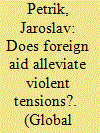

|
|
|
|
|
| Publication |
2008.
|
| Summary/Abstract |
Throughout most of its history, donors have perceived official development assistance (ODA) as a potentially helpful and mostly harmless form of intervention. Despite some destructive consequences, it was not until the late 1990s when the donor community realised that badly designed and insensitively implemented ODA can be just as disastrous to the recipient society as poorly executed military interventions or indiscriminate economic sanctions. Increasing interest in the impact of economic assistance on conflict made all major donor agencies adopt guidelines to avoid harming recipient societies and to maximise the positive impact of their aid on peace. This paper summarises the key literature on the role of ODA in ongoing conflicts as well as in times of peace, focusing on the influence of aid on violent tensions in the recipient societies. It traces the evolution of ideas which led to the recognition that aid can do harm. It argues that many of these connections, seemingly obvious, are unclear and likely to produce unmet expectations, and hence frustration.
|
|
|
|
|
|
|
|
|
|
|
|
|
|
|
|
| 5 |
ID:
138238
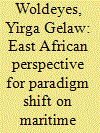

|
|
|
|
|
| Summary/Abstract |
This paper advances the view that the meaning of maritime security should be considered based on lessons of history and requirements of human well-being. It challenges the tendency to separately view maritime security from the political, economic and social structures of the East African littoral states. Based on a critical reading of the history of the development of violent colonial structures in the region, the paper shows that most security discourses in relation to East Africa advance a paradigm that legitimises the control and management of the region’s maritime domain under the surveillance of foreign powers. The framing of poverty and conflicts as internally caused and economically motivated power struggles within fragile states contributes to this paradigm. This paper argues that the East African maritime domain is an integral part of the hinterland, and maritime security should be understood from a perspective that addresses structural violence in the region.
|
|
|
|
|
|
|
|
|
|
|
|
|
|
|
|
| 6 |
ID:
137759
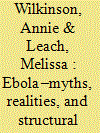

|
|
|
|
|
| Summary/Abstract |
TEN MONTHS AFTER THE FIRST INFECTION, Margaret Chan, Director-General of the World Health Organization, described the Ebola epidemic in West Africa as the ‘most severe acute public health emergency in modern times’. The disaster, she said, represents a ‘crisis for international peace and security’ and threatens the ‘very survival of societies and governments in already very poor countries’.1 As of October 2014, the disease had killed 4,951 and infected 13,567.2 It has crippled families, health systems, livelihoods, food supplies and economies in its wake. These numbers are likely to be vastly underestimated. How did it get to this? Why has this outbreak been so much larger than previous ones? The scale of the disaster has been attributed to the weak health systems of affected countries, their lack of resources, the mobility of communities and their inexperience in dealing with Ebola.3 This answer, however, is woefully de-contextualized and de-politicized. This briefing examines responses to the outbreak and offers a different set of explanations, rooted in the history of the region and the political economy of global health and development.
|
|
|
|
|
|
|
|
|
|
|
|
|
|
|
|
| 7 |
ID:
140773
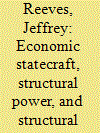

|
|
|
|
|
| Summary/Abstract |
This article employs the concepts of structural power and structural violence to a undertake critical study of China’s use of economic statecraft toward Kyrgyzstan. The article argues that China’s reliance on economic exchange to secure its strategic ends in Kyrgyzstan has resulted in asymmetric economic exchange between the two states. Through this asymmetric exchange, China has gained influence over Kyrgyzstan’s domestic structures. Chinese structural power, in turn, contributes to violence across Kyrgyzstan’s structures of economy, environment, and society and within the country’s state-society relations. Structural violence within Kyrgyzstan also results in periphery instability and domestic insecurity for China. As such, the article argues that China’s use of economic statecraft to achieve its strategic aims in Kyrgyzstan is self-defeating.
|
|
|
|
|
|
|
|
|
|
|
|
|
|
|
|
| 8 |
ID:
128313
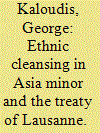

|
|
|
|
|
| Publication |
2014.
|
| Summary/Abstract |
George Kaloudis, discusses events in Greece and Turkey that led to a Christian Holy War against infidels in 1921, and how the Treaty of Lausanne, brokered by European states, reinforced the ethnic genocide that followed in its wake. The Treaty of Lausanne was rooted in the prevailing ideal of the "nation-state," in which each state would consist of a homogeneous ethnic nationality. This concept is, at its core, a concept of structural violence, because there is no such thing as a modern state in which all residents hold identical ethnic and cultural views. Yet, this concept still inspires elites to seek for the elusive ideal in which all citizens will identify with and agree with the policies of the state because they reinforce a particular national ethnic or religious culture.
|
|
|
|
|
|
|
|
|
|
|
|
|
|
|
|
| 9 |
ID:
177867
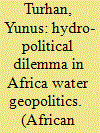

|
|
|
|
|
| Summary/Abstract |
Water-related conflict chronology can be grouped around two broad sets of ideas: On the one hand is material-related conflict such as water stress and under-development; while on the other is management-related conflict including state-failure and lack of governance. In line with the latter form of conflict, this paper gives a specific consideration to the three types of causal factors looming with the potential for conflict over the Nile basin: Political tensions among stakeholders, lack of all-inclusive agreement on management of the Nile water, and states' unilateral actions. By identifying these causal factors, this study limits itself to focus on the initial phase of conflict resolutions, that is diagnosing sources to select some aspects of perceived reality and make them more salient in the methodological context. Based on Johan Galtung's theoretical approaches on conflict dynamics, the paper explores two areas that are lacking in current literature. It accounts for the sources of conflict over the Nile basin hinging on three variables, while mapping the nature of the on-going negotiation process around Ethiopia's “Grand Ethiopian Renaissance Dam” construction. This process is distributive in form and offers a collaborative (win-win) form of negotiations to cement the latter and to redress current predicaments.
|
|
|
|
|
|
|
|
|
|
|
|
|
|
|
|
| 10 |
ID:
122382
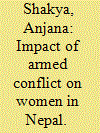

|
|
|
| 11 |
ID:
120789


|
|
|
|
|
| Publication |
2013.
|
| Summary/Abstract |
In many ways, the structural violence of settler colonialism continues to dominate the lived experience of Indigenous populations, including Aboriginal and Torres Strait Islander peoples in contemporary Australia. One aspect of this structural violence concerns the regulation of Indigenous identity, today perpetuated through state monitoring of the 'authenticity' of Aboriginal people. This article argues that the contest over Indigenous identity perpetuates a form of symbolic political violence against Indigenous people. It considers the ways in which structural violence against Indigenous identity has featured in Australia's settler colonial regime and examines the particular violence faced by urban-dwelling Aboriginal people, who endure much contemporary scrutiny of the 'authenticity' of their Indigeneity. As a case study, the article examines the symbolic violence associated with a particular legal case in Australia and, in light of this analysis, concludes that settler colonies could make a decolonising gesture by legislating for the protection of Indigenous identity.
|
|
|
|
|
|
|
|
|
|
|
|
|
|
|
|
| 12 |
ID:
080835
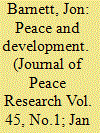

|
|
|
|
|
| Publication |
2008.
|
| Summary/Abstract |
This article develops a theory of peace as freedom that explains some important relationships between peace and development. It does this by critically examining and then synthesizing Johan Galtung's theory of peace as the absence of violence and Amartya Sen's theory of development as freedom. Galtung's theory of peace is clear on the meaning and causes of direct violence, but vague on the details of structural violence. Sen's theory helps overcome many of the problems associated with structural violence, although its focus on agents and the state tends to downplay the importance of larger-scale political and economic processes. In the theory of peace as freedom, peace is defined as, and in praxis is enlarged through, the equitable distribution of economic opportunities, political freedoms, social opportunities, transparency guarantees, protective security and freedom from direct violence. The institutions required for peace as freedom are considered, and it is suggested that the pluralist state is the best model for providing and maintaining peace as freedom. Some implications of this theory for existing and future analyses of the causes of violent conflict are discussed
|
|
|
|
|
|
|
|
|
|
|
|
|
|
|
|
| 13 |
ID:
172101
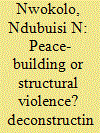

|
|
|
|
|
| Summary/Abstract |
There is a great conviction that the International Court of Justice’s ruling in 2002 on the Bakassi boundary dispute between Nigeria and Cameroon, and Nigeria’s decision to obey the ruling may have stopped a fierce inter-state war over the boundary. Indeed, many then ascribed to the whole boundary demarcation process as peacebuilding, disregarding the structural changes marked by the violence of forced migration. This article explores how the boundary delimitation has produced particular sorts of structural violence characterised by state neglect, loss of livelihoods and destitution. Thus, the article argues that although a full-blown war was avoided, the socio-economic conditions of the Nigerian populations on both sides of the border were not adequately considered and guaranteed as part of the peace-building agenda. It further argues that Nigeria, like many post-colonial states with the concentration of developments in major cities, neglects rural and border communities. Thus, the border communities accommodating the former Bakassi residents have further degenerated into ‘ill-governed’ spaces. This article uses structural violence as a framework to analyse the primary and secondary data to provide some deeper insights into the issues of violence being experienced by the local populations living on both sides of the demarcated border.
|
|
|
|
|
|
|
|
|
|
|
|
|
|
|
|
| 14 |
ID:
192924
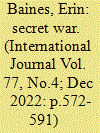

|
|
|
|
|
| Summary/Abstract |
Breaking the silence around wartime sexual violence is often understood as paramount to ending it. Many survivors feel compelled to publicly testify to prevent future harms, contest denial, and hold perpetrators to account. Yet, testimony is not always spoken, and silence should not be elided with powerlessness. In this article, we conceptualize the space in-between silence and voice as a form of multi-modal testimony that is given to protect, sustain, and reimagine relationships. We consider this in relation to the efforts of Adok, a woman abducted and forced into marriage by a rebel group in northern Uganda. Following her escape and return home with two children, Adok faced what is described as the “secret war”: ongoing structural and lateral violence. Her efforts to hold the father of her children to account attests to the “secret war,” and calls for a collective response to protect the future of her children.
|
|
|
|
|
|
|
|
|
|
|
|
|
|
|
|
| 15 |
ID:
159385
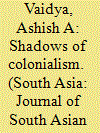

|
|
|
|
|
| Summary/Abstract |
This paper examines the status of tribal communities in central India through the lens of structural violence. In the process, a new and normatively grounded definition of violence is put forward which addresses weaknesses in the original definition proposed by Johan Galtung. The paper connects this new definition of structural violence to developmentalist and capitalist ideology, frameworks that benefit tribal communities by some empirical measures, but which must be recognised as profoundly violent in the normative contexts of those communities. Adivasis are caught between the competing imperatives of the Indian state's different and overlapping stages of modernist development: the remnants of the old colonial ‘civilising’ mission, a post-colonial nationalist industrialism and a post-industrial urge toward conservation. I argue that Galtung's definition is ill-suited to the task of describing this type of post-colonial structural violence, and that my definition solves this problem by accounting for the violence of conflicting normative frameworks.
|
|
|
|
|
|
|
|
|
|
|
|
|
|
|
|
| 16 |
ID:
165690
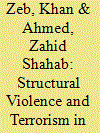

|
|
|
|
|
| Summary/Abstract |
The Federally Administered Tribal Areas (FATA) of Pakistan came under the international spotlight following the US-led invasion of Afghanistan in 2001.Mainly due to being a semi-autonomous region where British-colonial-era laws were practised until May 2018, FATA remains one of the most marginalised and insecure areas of Pakistan. Based on Galtung’s structural violence theory, this paper examines the nexus between the region’s socio-economic and political realities and terrorism. Through primary and secondary data, this paper argues that economic marginalisation and the lack of political and individual freedom of the tribal people are root causes of the instability in FATA.
|
|
|
|
|
|
|
|
|
|
|
|
|
|
|
|
| 17 |
ID:
140755
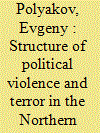

|
|
|
|
|
| Summary/Abstract |
The author relies on the structural violence concept to analyze political violence and terror in the Northern Caucasus throughout the 1990s-2000s, which brought him to the conclusion that direct armed violence, or even terror, are less dangerous than structural violence. The dynamics of their manifestations, however, is interconnected.
|
|
|
|
|
|
|
|
|
|
|
|
|
|
|
|
| 18 |
ID:
141290
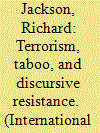

|
|
|
|
|
| Summary/Abstract |
More than a decade of the war on terror has increased levels of direct and structural violence and strengthened the forces of political oppression across the globe. Within this historical material context, as well as the intellectual context of the “narrative turn” and the wider “cultural turn” currently underway in International Relations, this article explores the ways in which the terrorism novel might act as a mode of discursive resistance or literary resistance to these (oppressive) forms of power, as a site of emancipatory agonistic politics, and as a social scientific method of analysis. Among possible forms of discursive resistance, the novel—as a narrative mode—has genuine potential due to its affective as opposed to confrontational form, its engagement with the emotional aspects of international politics, its lack of conventional boundaries, and its potential reach. However, to date, the terrorism novel has not realized its potential as a mode of resistance, but has instead tended to reinforce the counterterrorism truth regime by reinforcing and maintaining the modern terrorism taboo. In this respect, the publication of Confessions of a Terrorist: A Novel (Jackson 2014) represents something of a watershed, as it is one of the first sympathetic fictional depictions of a terrorist and the first to give primary voice to the perspective of the terrorist. Allowing the terrorist to speak not only acts to resist and undermine the terrorism taboo and generate empathetic projection, but potentially also creates an agonistic moment in which the violent subaltern can speak on an equal footing directly to the counterterrorist—and by extension, to the reader. The article concludes by reflecting on the potential of the novel as a site of both resistance and agonistic encounter and the challenges of employing literary resistance to domination.
|
|
|
|
|
|
|
|
|
|
|
|
|
|
|
|
| 19 |
ID:
113723
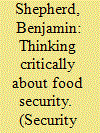

|
|
|
|
|
| Publication |
2012.
|
| Summary/Abstract |
This article examines the tension between food security as strategic practice and as the human insecurity of hunger. It makes the case that hunger is a security matter that warrants greater attention from security scholars, but identifies some limitations with state-centric and human security approaches. The article explores Ken Booth's 'emancipatory realism' security project as one avenue for overcoming these limitations and uses Booth's work to assist in developing a reframing of food security. It proposes redefining food security in terms of securing vulnerable populations from the structural violence of hunger, and argues that such a framing offers both conceptual and practical value for efforts to confront the problem of increasing and widespread hunger.
|
|
|
|
|
|
|
|
|
|
|
|
|
|
|
|
| 20 |
ID:
092124
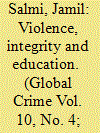

|
|
|
|
|
| Publication |
2009.
|
| Summary/Abstract |
In many parts of the world, schools, which are supposedly the main social venue for intellectual enrichment and value formation, are often places of suffering and distress, raising important questions about the relationship between violence and education. What are the different forms of violence that can be encountered in a schooling setting? How prevalent are these manifestations of violence? Do they occur in a random fashion or are they associated with specific factors and patterns? What can be done to reduce or eliminate their occurrence? To begin to address these questions, this article is divided into three parts. First, it proposes an analytical framework to identify, in a systematic way, the various forms of violence that can take place within the ambit of school systems. Second, it shows how this typology can be applied along the various analytical dimensions developed. Finally, it reviews ways in which education can be used as a positive force to address violence issues in the school context and beyond.
|
|
|
|
|
|
|
|
|
|
|
|
|
|
|
|
|
|
|
|
|